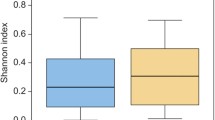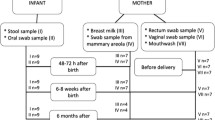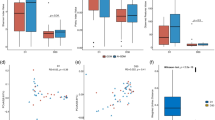Abstract
Strong evidence suggests that the early composition of the oral microbiota of neonates plays an important role for the postnatal development of the oral health or immune system. However, the relationship between the maternal microbiome and the initial neonatal microbiome remains unclear. In this study, 25 pregnant women and their neonates were recruited, and the samples were collected from the maternal oral cavity, amniotic fluid, placenta and neonatal oral cavity. High-throughput sequencing of 16S rRNA was performed using the Illumina MiSeq platform to analyze the correlation with microbial community structure between the maternal and the neonatal oral cavity. The results indicated that the number of shared OTUs was up to 635 in four groups. The PCoA showed that there were certain similarities in the microbial community structure of the four groups. The dominant bacterial genera of the shared OTUs were consistent with human oral microbes, including Streptococcus, Fusobacterium and Prevotella. The results showed that there might be a correlation between the maternal and neonatal oral microbiome, through the amniotic fluid and placenta.



Similar content being viewed by others
References
Dominguez-Bello MG, Costello EK, Contreras M, Magris M, Hidalgo G, Fierer N, Knight R (2010) Delivery mode shapes the acquisition and structure of the initial microbiota across multiple body habitats in newborns. Proc Natl Acad Sci USA 107:11971–11975. https://doi.org/10.1073/pnas.1002601107
Biasucci G, Benenati B, Morelli L, Bessi E, Boehm G (2008) Cesarean delivery may affect the early biodiversity of intestinal bacteria. J Nutr 138:1796s–1800s. https://doi.org/10.1093/jn/138.9.1796S
Gronlund MM, Lehtonen OP, Eerola E, Kero P (1999) Fecal microflora in healthy infants born by different methods of delivery: permanent changes in intestinal flora after cesarean delivery. J Pediatr Gastroenterol Nutr 28:19–25. https://doi.org/10.1097/00005176-199901000-00007
Salminen S, Gibson GR, McCartney AL, Isolauri E (2004) Influence of mode of delivery on gut microbiota composition in seven year old children. Gut 53:1388–1389. https://doi.org/10.1136/gut.2004.041640
Neu J (2015) Developmental aspects of maternal-fetal, and infant gut microbiota and implications for long-term health. Matern Health Neonatol Perinatol 1:6. https://doi.org/10.1186/s40748-015-0007-4
Rautava S, Luoto R, Salminen S, Isolauri E (2012) Microbial contact during pregnancy, intestinal colonization and human disease. Nat Rev Gastroenterol Hepatol 9:565–576. https://doi.org/10.1038/nrgastro.2012.144
Yang I, Corwin EJ, Brennan PA, Jordan S, Murphy JR, Dunlop A (2016) The infant microbiome: implications for infant health and neurocognitive development. Nurs Res 65:76–88. https://doi.org/10.1097/nnr.0000000000000133
Fardini Y, Chung P, Dumm R, Joshi N, Han YW (2010) Transmission of diverse oral bacteria to murine placenta: evidence for the oral microbiome as a potential source of intrauterine infection. Infect Immun 78:1789–1796. https://doi.org/10.1128/iai.01395-09
Neu J (2012) Diversity of microbes in amniotic fluid. In: Yearbook of neonatal and perinatal medicine, vol 2012, pp 55–56. https://doi.org/10.1016/j.ynpm.2012.05.017
DiGiulio DB, Romero R, Amogan HP, Kusanovic JP, Bik EM, Gotsch F, Kim CJ, Erez O, Edwin S, Relman DA (2008) Microbial prevalence, diversity and abundance in amniotic fluid during preterm labor: a molecular and culture-based investigation. PLoS ONE 3:e3056. https://doi.org/10.1371/journal.pone.0003056
Jimenez E, Fernandez L, Marin ML, Martin R, Odriozola JM, Nueno-Palop C, Narbad A, Olivares M, Xaus J, Rodriguez JM (2005) Isolation of commensal bacteria from umbilical cord blood of healthy neonates born by cesarean section. Curr Microbiol 51:270–274. https://doi.org/10.1007/s00284-005-0020-3
Aagaard K, Ma J, Antony KM, Ganu R, Petrosino J, Versalovic J (2014) The placenta harbors a unique microbiome. Sci Transl Med 6:237ra265. https://doi.org/10.1126/scitranslmed.3008599
Magoc T, Salzberg SL (2011) FLASH: fast length adjustment of short reads to improve genome assemblies. Bioinformatics 27:2957–2963. https://doi.org/10.1093/bioinformatics/btr507
Rognes T, Flouri T, Nichols B, Quince C, Mahe F (2016) VSEARCH: a versatile open source tool for metagenomics. PeerJ 4:e2584. https://doi.org/10.7717/peerj.2584
Edgar RC, Haas BJ, Clemente JC, Quince C, Knight R (2011) UCHIME improves sensitivity and speed of chimera detection. Bioinformatics 27:2194–2200. https://doi.org/10.1093/bioinformatics/btr381
Romano-Keeler J, Weitkamp JH (2015) Maternal influences on fetal microbial colonization and immune development. Pediatr Res 77:189–195. https://doi.org/10.1038/pr.2014.163
Oh KJ, Lee SE, Jung H, Kim G, Romero R, Yoon BH (2010) Detection of ureaplasmas by the polymerase chain reaction in the amniotic fluid of patients with cervical insufficiency. J Perinat Med 38:261–268. https://doi.org/10.1515/jpm.2010.040
Jimenez E, Marin ML, Martin R, Odriozola JM, Olivares M, Xaus J, Fernandez L, Rodriguez JM (2008) Is meconium from healthy newborns actually sterile? Res Microbiol 159:187–193. https://doi.org/10.1016/j.resmic.2007.12.007
van Winkelhoff AJ, Rurenga P, Wekema-Mulder GJ, Singadji ZM, Rams TE (2016) Non-oral gram-negative facultative rods in chronic periodontitis microbiota. Microb Pathog 94:117–122. https://doi.org/10.1016/j.micpath.2016.01.020
Sampaio-Maia B, Monteiro-Silva F (2014) Acquisition and maturation of oral microbiome throughout childhood: an update. Dent Res J (Isfahan) 11:291–301
Tong XL, Wang L, Gao TB, Qin YG, Qi YQ, Xu YP (2009) Potential function of amniotic fluid in fetal development—novel insights by comparing the composition of human amniotic fluid with umbilical cord and maternal serum at mid and late gestation. J Chin Med Assoc 72:368–373. https://doi.org/10.1016/s1726-4901(09)70389-2
Brace RA (1995) Progress toward understanding the regulation of amniotic fluid volume: water and solute fluxes in and through the fetal membranes. Placenta 16:1–18. https://doi.org/10.1016/0143-4004(95)90077-2
Kreth J, Merritt J, Qi F (2009) Bacterial and host interactions of oral streptococci. DNA Cell Biol 28:397–403. https://doi.org/10.1089/dna.2009.0868
Jenkinson HF, Lamont RJ (1997) Streptococcal adhesion and colonization. Crit Rev Oral Biol Med 8:175–200. https://doi.org/10.1177/10454411970080020601
Han YW, Ikegami A, Bissada NF, Herbst M, Redline RW, Ashmead GG (2006) Transmission of an uncultivated Bergeyella strain from the oral cavity to amniotic fluid in a case of preterm birth. J Clin Microbiol 44:1475–1483. https://doi.org/10.1128/jcm.44.4.1475-1483.2006
Bearfield C, Davenport ES, Sivapathasundaram V, Allaker RP (2002) Possible association between amniotic fluid micro-organism infection and microflora in the mouth. BJOG 109:527–533. https://doi.org/10.1111/j.1471-0528.2002.01349.x
Vesty A, Biswas K, Taylor MW, Gear K, Douglas RG (2017) Evaluating the impact of DNA extraction method on the representation of human oral bacterial and fungal communities. PLoS ONE 12:e0169877. https://doi.org/10.1371/journal.pone.0169877
Acknowledgements
This study was supported financially by the Area Fund Projects of the Chinese National Natural Science Fund (31560159 and 31360124/C0309), Nature Science Foundation of Gansu Province (17JR5RA217), the Science and Technology Support Project in Gansu Province (17JR5RA274 and 144WCGA167), and the Key Colleges and Universities Focus on Nurturing Project (31920180017, 31920180128). This study was fully sponsored by Gansu genenbio-yes Biotechnology Cd., Ltd and Gansu MeiTa Biomedicine Co., Ltd. The funders played no role in the study design, data collection and interpretation or in the decision to submit the work for publication.
Author information
Authors and Affiliations
Corresponding authors
Ethics declarations
Conflict of interest
The authors declare that no conflict of interest exists in the study.
Informed Consent and Ethical Approval
Informed consent forms were signed by all participants included the mothers have provided the informed consent for their neonates in the study. All procedures performed in studies involving human participants met the ethical standards of the Ethics Committee of the School of Stomatology Lanzhou University (LZUE-201700012) and with the 1964 Helsinki declaration and its later amendments or comparable ethical standards.
Additional information
Publisher's Note
Springer Nature remains neutral with regard to jurisdictional claims in published maps and institutional affiliations.
Electronic supplementary material
Below is the link to the electronic supplementary material.
Rights and permissions
About this article
Cite this article
Wu, S., Yu, F., Ma, L. et al. Do Maternal Microbes Shape Newborn Oral Microbes?. Indian J Microbiol 61, 16–23 (2021). https://doi.org/10.1007/s12088-020-00901-7
Received:
Accepted:
Published:
Issue Date:
DOI: https://doi.org/10.1007/s12088-020-00901-7




